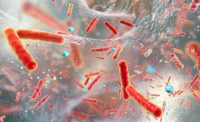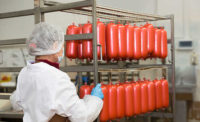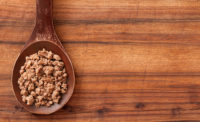|
Loss of sensory quality in muscle foods is often caused by lipid oxidation, which can be inhibited by the use of antioxidants. Because of health concerns of synthetic antioxidants, there has been an increasing demand for natural antioxidants. Phospholipase A2 (PLA2), a lipolytic enzyme that hydrolyzes phospholipids, was linked to increased oxidative stability of frozen cod muscles (Castell & Bishop, 1969). Therefore, PLA2 could be an alternative natural antioxidant from pancreas, an animal by-product, which serves as an excellent source for the enzyme. However, information on the effect of PLA2 from pig pancreas on lipid oxidation in poultry and pork are still lacking. |
The effect of PLA2 (10 mg/kg muscle) was tested independently in cod fillet, chicken (thighs and drumsticks) and pork (semitendinosus) muscles by adding different pro-oxidants. The muscles were prepared by cutting and grinding through a 5-mm plate. Additionally, ground chicken and pork were minced using a Waring blender. Hemoglobin (Hb) was added to ground cod muscle to stimulate lipid oxidation due to low levels of endogenous heme proteins, potent promoters of lipid oxidation in fish. For pork, instead of hemoglobin, NaCl was added at 1.5 percent by weight to promote lipid oxidation. In contrast, no exogenous pro-oxidant was added into minced chicken since lipid oxidation occurs readily. In all cases, control samples were treated with deionized water instead of PLA2. Ground muscles were separately stored in amber-colored glass bottles and stored on ice (0.2°C) in order to minimize microbial growth and to allow lipid oxidation to proceed at an optimal rate for sampling. Lipid oxidation was measured as peroxide value (PV) and thiobarbituric acid reactive substances (TBARS). The experiment design was completely randomized design (n = 3) with repeated measurements and data were analyzed using SAS.
In ground cod muscle, PLA2 suppressed hemoglobin-promoted lipid oxidation (measured as TBARS) by 85 percent (10.69 vs. 73.07 µmol malondialdehyde/kg muscle; p<0.01), compared with the control samples at Day 5.
In minced pork, the addition of NaCl effectively induced lipid oxidation (p<0.01) and substantially suppressed the activity of the added PLA2, measured as free fatty acids (p<0.01), compared with unsalted samples. At Day 12, the salted pork treated with PLA2 had lower PV and TBARS than the salted pork control by 67 percent (42.67 vs. 129.99 µmol lipid hydroperoxides/kg muscle; p<0.01) and by 24 percent (23.07 vs. 30.36 µmol malondialdehyde/kg muscle; p<0.01), respectively. These results in pork were also in agreement with 43 percent lower hexanal, a volatile product of lipid oxidation measured using gas chromatography, in PLA2-treated salted pork than in control salted pork (6.00 vs. 10.53 µmol hexanal/kg muscle; p<0.01) at Day 12.
Despite the observed antioxidant effect in cod and pork muscles, PLA2 significantly accelerated lipid oxidation of minced chicken measured as PV (706.83 vs. 377.04 µmol lipid hydroperoxides/kg muscle; p<0.01) and TBARS (104.75 vs. 48.36 µmol malondialdehyde/kg muscle; p<0.01), compared with control samples at Day 5.
In conclusion, PLA2 from pig pancreas can either inhibit (cod and pork muscles) or promote (chicken muscle) lipid oxidation in minced muscles, and NaCl can interfere with PLA2 activity. Various intrinsic factors (e.g. pH, presence of endogenous antioxidants and pro-oxidants, fatty acid profiles etc.) may be responsible for the inconsistent effects of PLA2 on lipid oxidation in muscles from different animal species. Therefore, understanding of how phospholipid hydrolysis by PLA2 affects lipid oxidation is necessary for implementing PLA2 to improve eating quality of muscle foods.




Report Abusive Comment